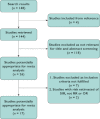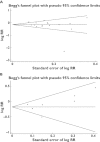Meta-analysis on the association between non-steroidal anti-inflammatory drug use and ovarian cancer
- PMID: 22471948
- PMCID: PMC3555044
- DOI: 10.1111/j.1365-2125.2012.04290.x
Meta-analysis on the association between non-steroidal anti-inflammatory drug use and ovarian cancer
Abstract
Aim: Animal and in vitro studies suggest that the use of non-steroidal anti-inflammatory drugs (NSAIDs) may be associated with reduced risk for ovarian cancer. However, results from these studies have been inconsistent. The aim of our study was to review and summarize the evidence provided by longitudinal studies on the association between NSAID use and ovarian cancer risk.
Methods: A comprehensive literature search for articles published up to December 2011 was performed. Prior to performing a meta-analysis, the studies were evaluated for publication bias and heterogeneity. Relative risk (RR) or odds ratios (OR) were calculated.
Results: Seventeen reports (13 case-control studies, one clinical trial and three cohort studies), published between 1998 and 2011 were identified. There was no evidence of an association between aspirin use and ovarian cancer risk based on a random-effects model (RR = 0.91, 95% confidence interval (CI) 0.82, 1.01) or a fixed-effects model (RR = 0.94, 95% CI 0.87, 1.01). Similarly, we did not find strong evidence of an association between non-aspirin NSAID use and ovarian cancer using a random-effects model (RR = 0.89, 95% CI 0.74, 1.08) or a fixed-effects model (RR = 0.86, 95% CI 0.76, 0.98). Furthermore, our analysis did not show a strong association between frequency or duration of non-aspirin-NSAID use and ovarian cancer.
Conclusions: Our findings indicate that there is no strong evidence of an association between aspirin/NA-NSAID use and ovarian cancer. However, this subject deserves further investigation.
© 2012 The Authors. British Journal of Clinical Pharmacology © 2012 The British Pharmacological Society.
Figures




Similar articles
-
Do nonsteroidal anti-inflammatory drugs affect the risk of developing ovarian cancer? A meta-analysis.Br J Clin Pharmacol. 2005 Aug;60(2):194-203. doi: 10.1111/j.1365-2125.2005.02386.x. Br J Clin Pharmacol. 2005. PMID: 16042673 Free PMC article.
-
Aspirin, other NSAIDs, and ovarian cancer risk (United States).Cancer Causes Control. 2002 Aug;13(6):535-42. doi: 10.1023/a:1016380917625. Cancer Causes Control. 2002. PMID: 12195643
-
Nonsteroidal anti-inflammatory drug use and the risk of melanoma: a meta-analysis.Eur J Cancer Prev. 2014 Jan;23(1):62-8. doi: 10.1097/CEJ.0b013e328360f479. Eur J Cancer Prev. 2014. PMID: 23549150
-
Association between nonsteroidal anti-inflammatory drug use and brain tumour risk: a meta-analysis.Br J Clin Pharmacol. 2014 Jul;78(1):58-68. doi: 10.1111/bcp.12311. Br J Clin Pharmacol. 2014. PMID: 24341448 Free PMC article. Review.
-
Epidemiology of non-steroidal anti-inflammatory drugs and cancer.Prog Exp Tumor Res. 2003;37:1-24. doi: 10.1159/000071364. Prog Exp Tumor Res. 2003. PMID: 12795046 Review.
Cited by
-
Reducing Cardiovascular and Cancer Risk: How to Address Global Primary Prevention in Clinical Practice.Clin Cardiol. 2015 Jun;38(6):387-94. doi: 10.1002/clc.22394. Epub 2015 Apr 14. Clin Cardiol. 2015. PMID: 25873555 Free PMC article. Review.
-
Epidemiology of ovarian cancer: a review.Cancer Biol Med. 2017 Feb;14(1):9-32. doi: 10.20892/j.issn.2095-3941.2016.0084. Cancer Biol Med. 2017. PMID: 28443200 Free PMC article.
-
Risk-Reducing Strategies for Ovarian Cancer in BRCA Mutation Carriers: A Balancing Act.Oncologist. 2017 Apr;22(4):450-459. doi: 10.1634/theoncologist.2016-0444. Epub 2017 Mar 17. Oncologist. 2017. PMID: 28314837 Free PMC article.
-
Identification of luminal breast cancers that establish a tumor-supportive macroenvironment defined by proangiogenic platelets and bone marrow-derived cells.Cancer Discov. 2012 Dec;2(12):1150-65. doi: 10.1158/2159-8290.CD-12-0216. Epub 2012 Aug 15. Cancer Discov. 2012. PMID: 22896036 Free PMC article.
-
Dual Actions of Ketorolac in Metastatic Ovarian Cancer.Cancers (Basel). 2019 Jul 24;11(8):1049. doi: 10.3390/cancers11081049. Cancers (Basel). 2019. PMID: 31344967 Free PMC article. Review.
References
-
- Tingulstad S, Skjeldestad FE, Halvorsen TB, Hagen B. Survival and prognostic factors in patients with ovarian cancer. Obstet Gynecol. 2003;101:885–91. - PubMed
-
- NIH consensus conference. Ovarian cancer. Screening, treatment, and follow-up. NIH Consensus Development Panel on Ovarian Cancer. JAMA. 1995;273:491–7. - PubMed
-
- Ness RB, Cottreau C. Possible role of ovarian epithelial inflammation in ovarian cancer. J Natl Cancer Inst. 1999;91:1459–67. - PubMed
-
- Schildkraut JM, Moorman PG, Halabi S, Calingaert B, Marks JR, Berchuck A. Analgesic drug use and risk of ovarian cancer. Epidemiology. 2006;17:104–7. - PubMed
Publication types
MeSH terms
Substances
LinkOut - more resources
Full Text Sources
Medical

